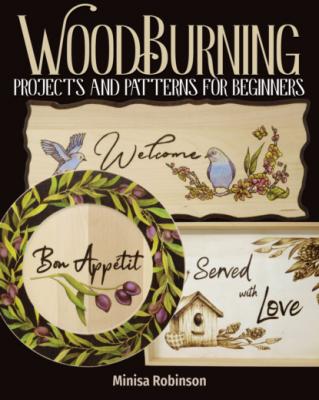Woodburning Projects and Patterns for Beginners. Minisa Robinson
Читать онлайн.| Название | Woodburning Projects and Patterns for Beginners |
|---|---|
| Автор произведения | Minisa Robinson |
| Жанр | Сделай Сам |
| Серия | |
| Издательство | Сделай Сам |
| Год выпуска | 0 |
| isbn | 9781607657828 |
Be willing to give life to new ideas.
My second woodburning project was on another small section of the aspen tree I cut down. At that time, I was afraid that the woodburning smoke would possibly trigger the smoke alarms of our small cabin, so I made this outside on the deck. It was a frigid autumn afternoon, and the woodburner was the only thing keeping my hands from getting too cold. I had no reference photo or guidelines and sketched out this small elk before dark. After the project was finished, I showed my husband, and his kind words were the spark that encouraged me to try again.
My second woodburning project, burned without any references.
Embrace the practice of practice.
This was my third project and the first time I used a printed-out reference photo with graphite paper. It was a big help to lay out the outlines of the piece, and I used the Dremel® tool to carve out the sun behind the bison. At this point, I realized that my options for pyrography were truly unlimited and I couldn’t wait to try more ideas.
My third project opened my eyes to the unlimited possibilities pyrography can offer.
Imagination and creativity know no bounds.
Most of my first projects were created on round pieces of aspen, but I wanted to try a flat piece, so my husband cut a slab of aspen with his chainsaw for me. This was my first flat woodburning, and I quickly realized the importance of sanding the wood before burning. The surface was very rough and difficult to burn on, and at this point, I was still experimenting with different tips and ways to use them. This woodburning piece was a huge learning experience, and it pushed me to create more realistic woodburnings.
My first flat project taught me the importance of first sanding your wood.
Chapter 1
WOODBURNING SAFETY AND SETUP
Woodburning is a delightful art form full of many possibilities. Because of its versatile nature, it’s a good idea to learn more about the safety aspects of the art. Some woodburning tools can easily reach over 1,000 degrees F (540 degrees C); therefore, they present a possible danger of fire and personal burns. The following tips can help you enjoy the art of woodburning safely.
To reduce the risks of fire:
• Never leave a woodburner unattended.
• Keep combustible materials away from the hot tool.
• Keep pets and children away from the unit.
• Secure the hot burner with a stand or holder.
• Keep cords out from underfoot.
• Use common sense when handling the hot tool.
For personal safety:
• Burn in a well-ventilated area.
• Give yourself plenty of room to work.
• Wear a glove while burning to help protect your fingers.
• Never change out points with your hands; use needle-nosed pliers instead.
• Don’t burn near water or liquids.
• Work on an incline to allow heat to rise up and away from your hand.
• An inclined surface can also help your back and neck.
• Never use a woodburning tool during an electrical storm.
To protect your lungs:
• Burn on unfinished wood only.
• Never burn over wood with a clear coat, varnish, paint, etc. Doing so could produce toxic fumes.
• Only add color after the burning is complete. Burning over pigments can also create toxic fumes.
• Never burn on plastic, medium-density fiberboard (MDF), particle boards, or any wood that is bound together with glues.
• Always wear a dust mask when sanding.
• Use a respirator for applying clear coats.
• If you burn on leather, choose vegetable-tanned leather only.
• Do your research before attempting to burn on a new wood species. Most woods are safe, but a few can produce toxins when burned. There are some resourceful websites on wood safety; however, if you’re unsure, consult a wood specialist.
To protect the woodburner:
• Never change out points when a burner is on. You can damage the threads and/or shear the point off completely. Always wait until the woodburner has completely cooled before replacing points.
• Use light pressure when burning. Pressing down firmly can bend or damage the points or burner.
Keep the woodburning tool secure at all times.
Wearing a glove can protect against accidental burns. I use a simple gardening glove from my local store, but it has saved my fingers from excessive heat and unintentional burns.
Wear a respirator when applying clear coats or burning dark backgrounds, which can produce more smoke.
Bent point due to excessive pressure
Some artists plug in their burning unit and get comfy; burning in their easy chairs or even their beds. However, I strongly recommend working at a desk with adequate space and lighting. It’s important to secure your woodburning tool while working to help prevent the risk of fire. Also, keep your workspace free of papers, tissues, or other flammable items. Finally, always keep beverages or water far from the electric burner!
A flat desk is a great start, but using an inclined desk can help prevent neck and back pain, making the woodburning experience more enjoyable. I purchased this adjustable drafting table from an online retailer, but you can also use a tabletop easel with some adjustment.
Avoid neck and back pain by using an inclined desk.
Chapter 2
TOOLS AND EQUIPMENT
It takes very few supplies to get started in pyrography, most of which
